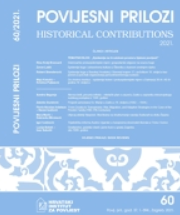Nervus belli, pecunia infinita – mletački plan o zauzeću Zadra u zapisniku inkvizicijskoga sudskog postupka iz 1346. godine
Nervus belli, pecunia infinita – The Venetian Plan for Occupying Zadar in the Trial Record of an Inquisitorial Procedure from 1346
Author(s): Sandra BegonjaSubject(s): History of Law, Criminal Law, Military history, 13th to 14th Centuries, 15th Century, Court case
Published by: Hrvatski institut za povijest
Keywords: Zadar; 14th century; siege of Zadar; Venetians; Tuscan mercenaries; criminal court records; inquisitorial procedure;
Summary/Abstract: An unknown trial record of an inquisitorial procedure from 14th-century Zadar has been found among the documents of the Zaratin noble family of Fanfogna, in the “Fanfogna-Garagnin” family fond in the State Archives in Split. The document is preserved in an 18th-century copy. The inquisitorial procedure was initiated and conducted by the Zaratin criminal court against the Florentine nobleman Uguiccione Dellosti on September 16-17, 1346. Uguiccione was accused of secret dealings with Venetian commanders in order to conquer the city from within during the last phase of the Venetian siege. Considering that the trial record was copied from the lost criminal court register for medieval Zadar (Quaternus criminalium), this document is also the only written testimony about the criminal justice system and court practice in Zadar during the first half of the 14th century. Also, the copy confirms that the register was still in Zadar during the 18th century. This article analyses the main features of the copy as well as the content of the original legal text (trial record) in order to determine the authenticity of the data and their correlation with similar data in other sources from the same period. The copy was made by Domenico Ignazio Frauenberger, the Zaratin archivist of the Fanfogna library, at some point in the second half of the 1760s. This conclusion has been reached on the basis of a comparative analysis of the main features of this copy and some other copies in the same archival fond (mostly handwritten). However, the authorship and date of the copy have been confirmed by a signed personal letter of Frauenberger’s, found in the same bundle. A structural analysis of the text has revealed Frauenberger’s interventions during the copying process as well as some late interventions by an unknown person. Also, the original text shows similarities with other inquisitorial records of some Italian communes (13th-15th centuries), mostly in structure and the legal formula, which indicates a possible use of common legal templates. The original text from 1346 also shows similarities with another Zaratin trial record from 1412, which indicates a similar way of keeping inquisitorial records in the second half of the 14th century. A content analysis of the original text has confirmed the legal and military political aspects that determine the value of this document. The analysis of the legal aspect has established the type of legal document (trial record), the structure of the inquisitorial procedure, and the composition and jurisdiction of the criminal court. These data are also an important indicator of the penal system in medieval Zadar, about which we have almost no knowledge. The inquisitorial procedure was short and kept in secret. The method of torture was applied in order to extract a true statement.
Journal: Povijesni prilozi
- Issue Year: 2021
- Issue No: 60
- Page Range: 131-178
- Page Count: 48
- Language: Croatian

